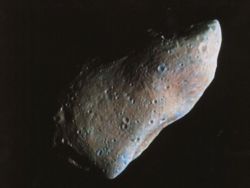Difference between revisions of "Resources in space"
From AdCiv
| Line 2: | Line 2: | ||
{{backto|Colonising Space}} | {{backto|Colonising Space}} | ||
[[Image:951 Gaspra.jpg|right|250px]] | [[Image:951 Gaspra.jpg|right|250px]] | ||
| − | The book {{wp|Mining_the_Sky:_Untold_Riches_from_the_Asteroids%2C_Comets%2C_and_Planets|Mining the Sky}} by {{wp|John_S._Lewis|John S. Lewis}} explains in some detail what abundant resources are available in our solar system, even in near-Earth orbits. | + | The book {{wp|Mining_the_Sky:_Untold_Riches_from_the_Asteroids%2C_Comets%2C_and_Planets|Mining the Sky}} by {{wp|John_S._Lewis|John S. Lewis}} explains in some detail what abundant resources are available in our solar system, even in near-Earth orbits. For example, the near-Earth asteroid {{wp|(6178)_1986_DA|(6178) 1986 DA}} contains 10,000 tons of gold, 100,000 tons of platinum, 10 billion tons of iron and a billion tons of nickel. |
See {{wp|Solar_power_satellite|solar power satellite}} and {{wp|Solar_furnace|solar furnace}} for harnessing the energy of the sun in space. | See {{wp|Solar_power_satellite|solar power satellite}} and {{wp|Solar_furnace|solar furnace}} for harnessing the energy of the sun in space. | ||
Revision as of 14:31, 8 July 2010
| << Page in early stages >> |
|---|
The book Mining the Sky  by John S. Lewis
by John S. Lewis  explains in some detail what abundant resources are available in our solar system, even in near-Earth orbits. For example, the near-Earth asteroid (6178) 1986 DA
explains in some detail what abundant resources are available in our solar system, even in near-Earth orbits. For example, the near-Earth asteroid (6178) 1986 DA  contains 10,000 tons of gold, 100,000 tons of platinum, 10 billion tons of iron and a billion tons of nickel.
contains 10,000 tons of gold, 100,000 tons of platinum, 10 billion tons of iron and a billion tons of nickel.
See solar power satellite  and solar furnace
and solar furnace  for harnessing the energy of the sun in space.
for harnessing the energy of the sun in space.
See also
- Fundamental resources (on Earth)

